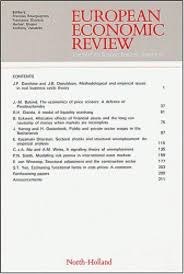
Moraga-González, J.L. and Viaene, J.M. (2005). Trade policy and quality leadership in transition economies European Economic Review, 49(2):359--385.
-
Affiliated authorsJosé Luis Moraga-González, Jean-Marie Viaene
-
Publication year2005
-
JournalEuropean Economic Review
Trade policy and quality leadership in transition economies are analyzed in a duopoly model of trade and vertical product differentiation. We first show that the incidence of trade liberalization is sensitive to whether firms in transition economies are producers of low or high quality. Second, we find that neither free trade nor the absence of a domestic subsidy are optimal: Both a tariff and a subsidy increase price competition and while the former extracts foreign rents the latter results in quality upgrading. Third, there exists a rationale for a government to commit to a socially optimal policy to induce quality leadership by the domestic firm when cost asymmetries are low. Finally, we establish an equivalence result between the effects of long-run exchange rate changes and those of trade policy on price competition (but not on social welfare).